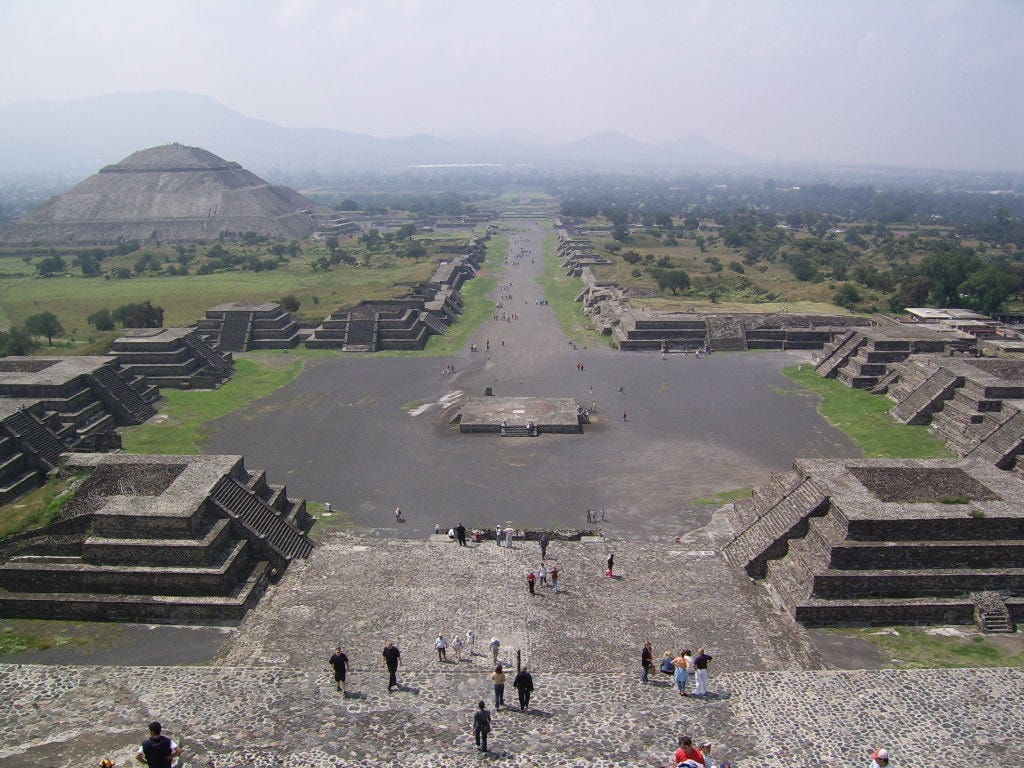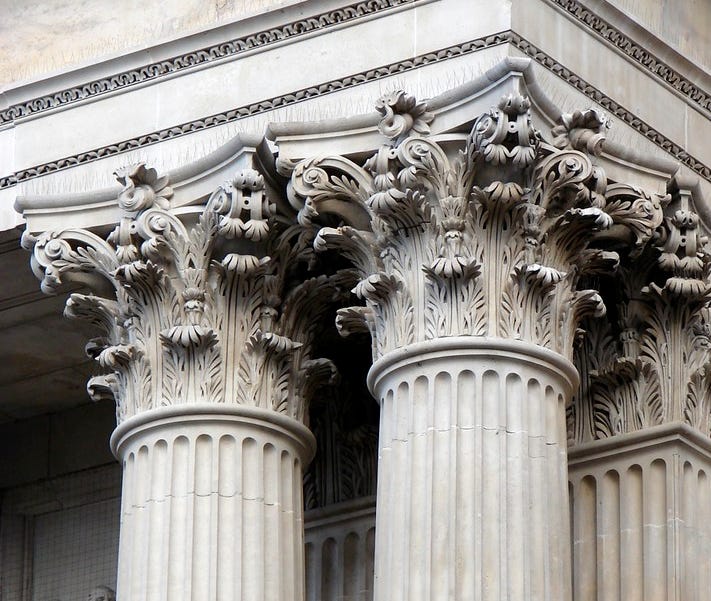Evolutionary Architecture: 2. Humans Love Symmetry
Buildings from every corner of the world share one striking feature: symmetry. This isn't random — our love of symmetry comes directly from human nature.
What is symmetry?
In simple terms, symmetry means that one side of something mirrors the other. If you draw a line down the middle of a symmetrical object, both halves match.1 This is called bilateral symmetry, and the most beautiful buildings have a lot of it.
There are other types too:
Rotational symmetry — like the round rose windows in churches such as Notre Dame
Translational symmetry — patterns, such as in wallpaper or tiles
While these other types also appeal to us, this article focuses on bilateral symmetry — the most common type in architecture.
Symmetry is everywhere
Our preference for symmetry transcends cultures, geographies and history. It's universal. From the great cathedrals and palaces of Europe to Asian temples and pagodas and native Mesoamerican pyramids (Figure 2.1), symmetry has always been seen as a crucial principle for beauty. Not only in the architecture of building exteriors, but also in the design of furniture, interiors and everyday objects.
The Roman architect Vitruvius recognised this over 2,000 years ago:
Eurythmy [i.e. harmony] is beauty and fitness in the adjustments of the members. This is found when the members of a work are of a height suited to their breadth, of a breadth suited to their length, and, in a word, when they all correspond symmetrically.
Vitruvius, The Ten Books on Architecture (Chapter II, Sec. 3) (c. 15–20 BCE)
Figure 2.1. Symmetrical pyramid-temples in Teotihuacán, Mexico — even the city layout is symmetrical.
Do we learn to like symmetry from our culture or are we born preferring it? Native American civilisations built perfectly symmetrical pyramids and created symmetrical ornaments long before Columbus arrived in 1492, and their ornaments were symmetrical as well.2 They had no contact with Europe, Asia, or Africa. Yet they developed the exact same preference for symmetry. What are the odds that completely separate cultures would accidentally develop identical aesthetic preferences? Why did the Aztecs, who never met a European, build pyramids exactly like the Egyptians preferred them – perfectly symmetrical? The answer reveals a hidden truth about human nature: Our preference for symmetry is in innate. Symmetry had sprung up in human building practices before the first architect was even born (Imhotep is considered to be the very first architect in history). Consider these facts:
Ancient Egyptians built symmetrical temples and pyramids millennia before the dawn of Western Civilization
Japan and China independently developed symmetrical building styles
None of these civilizations had yet made contact with each other
Every civilisation extends this preference to pottery, furniture, and decorationMoreover, in all these civilisations the preference for symmetry extends to pottery, furniture and ornament.
Even Charles Darwin noticed this pattern:
‘… the eye prefers symmetry or figures with some regular recurrence. Patterns of this kind are employed by even the lowest savages as ornaments; and they have been developed through sexual selection for the adornment of some male animals.’
Charles Darwin, The Descent of Man and Selection in Relation to Sex, published in 1882.
Figure 2.2. The Forbidden City in Beijing — built in the 1400s with perfect symmetry.
Figure 2.3. The great temple of Abu Simbel, Egypt. Built in the 13th century B.C for Ramses II.
Figure 2.4. Villa Rotonda, built in 1566 and designed by Andrea Palladio, one of the great architects of the Renaissance.
Evidently, there’s only one right answer to the nature versus nurture question — Human nature is at play.
What science tells us
Modern brain research confirms what history suggests. Architect and researcher Ann Sussman explains:
‘More recently, psychologists have tried to tease apart the extent preferences for symmetry appear to be hardwired in us, independent of our cultural or ‘savage’ heritage. Recent psychology studies, for instance, have explored whether adding symmetrical patterns to faces and craft objects enhances their appeal. They do, the studies reported: people consistently prefer symmetrical additions over the asymmetric (Cardenas and Harris, 2006). Researchers also note symmetrical patterns prevail in arts and crafts cross-culturally, whether it is in pottery, fabric design, tile ornamentation, or body decoration. Significantly, the tendency in crafts also seems to have arisen independently throughout the world, suggesting its primal place for our species. Bilateral symmetric objects are found in diverse, far-flung regions, ranging from the Navajo in the American West, to the Aonikenk, tribes of Patagonia, South America, to the Yoruba tribe of Nigeria (Cardenas and Harris 2006).’
(Ann Sussman in Cognitive Architecture, page 118/193)
Figure 2.5. Corinthian capitals — almost perfectly symmetrical along multiple axes and containing symmetrical ornaments mostly in the shape of foliage.
Figure 2.6. Symmetrical ornaments in the Forbidden City, in Beijing.
Why do we love symmetry?
Scientists think our preference for symmetry might have to do with faces. Sussman notes that we've evolved to quickly read faces, and faces are symmetrical. This theory suggests:
We find symmetrical faces more attractive (possibly signalling good health)
This preference spreads to other objects we make
Symmetrical buildings feel familiar and reassuring because they echo the facial pattern we've known since birth
Faces help us navigate the world from infancy. Buildings that mirror this familiar pattern might naturally comfort us. Sussman writes:
‘They also hypothesize why the preference prevails: “One possibility is that the adaptive value of detecting symmetry in potential mates generalizes to other objects” (ibid: 16). Perhaps because we like looking at faces and have evolved to take in and emotionally read them quickly, we also favor the main facial attribute, bilateral symmetry, in things we make and place around us. Faces ground and orient us in a random world from infancy onward. One might hypothesize there is a certain efficiency and predictability to designing buildings that reflect this arrangement not only because we are predisposed to take the form in, but because such new constructions may more likely reassure us, too.’
(Ann Sussman in Cognitive Architecture, page 120/193)
Our preference for symmetry is evident from history, found in every culture and time period, and confirmed by neurological and psychological research. It’s a human universal rooted in our evolution. Imagine walking toward St Paul's Cathedral. Now mentally push the left tower 10 metres forward. Feels wrong, doesn't it? Your brain just rebelled against asymmetry. Symmetry is to architecture what rhythm is to music — break it without good reason, and people instinctively feel something's wrong. Next time you enter a building and feel immediately comfortable or uncomfortable, check its symmetry. You'll start noticing how architecture manipulates your instincts. You might think: 'But I know asymmetrical buildings I like!' True — but notice they usually have other symmetrical elements, or they're the exception that proves the rule.
What's next
The next article will explore another universal feature of beautiful architecture: ornament. We'll discover that, like symmetry, humans everywhere share specific preferences for decoration — and we'll uncover what those preferences are.
Click here for the next article of this series.
“Symmetry, in geometry, is the property by which the sides of a figure or object reflect each other across a line (axis of symmetry) or surface.” Encyclopaedia Britannica, retrieved on 11 September 2021 from https://www.britannica.com/topic/symmetry-definition
Walker, N., ‘Mayan Classicism: Axial Symmetry in Uxmal (Part II of II)’, published on 13 January 2011, retrieved on 12 September 2021 from https://www.classicist.org/articles/mayan-classicism-axial-symmetry-in-uxmal-part-ii-of-ii/






